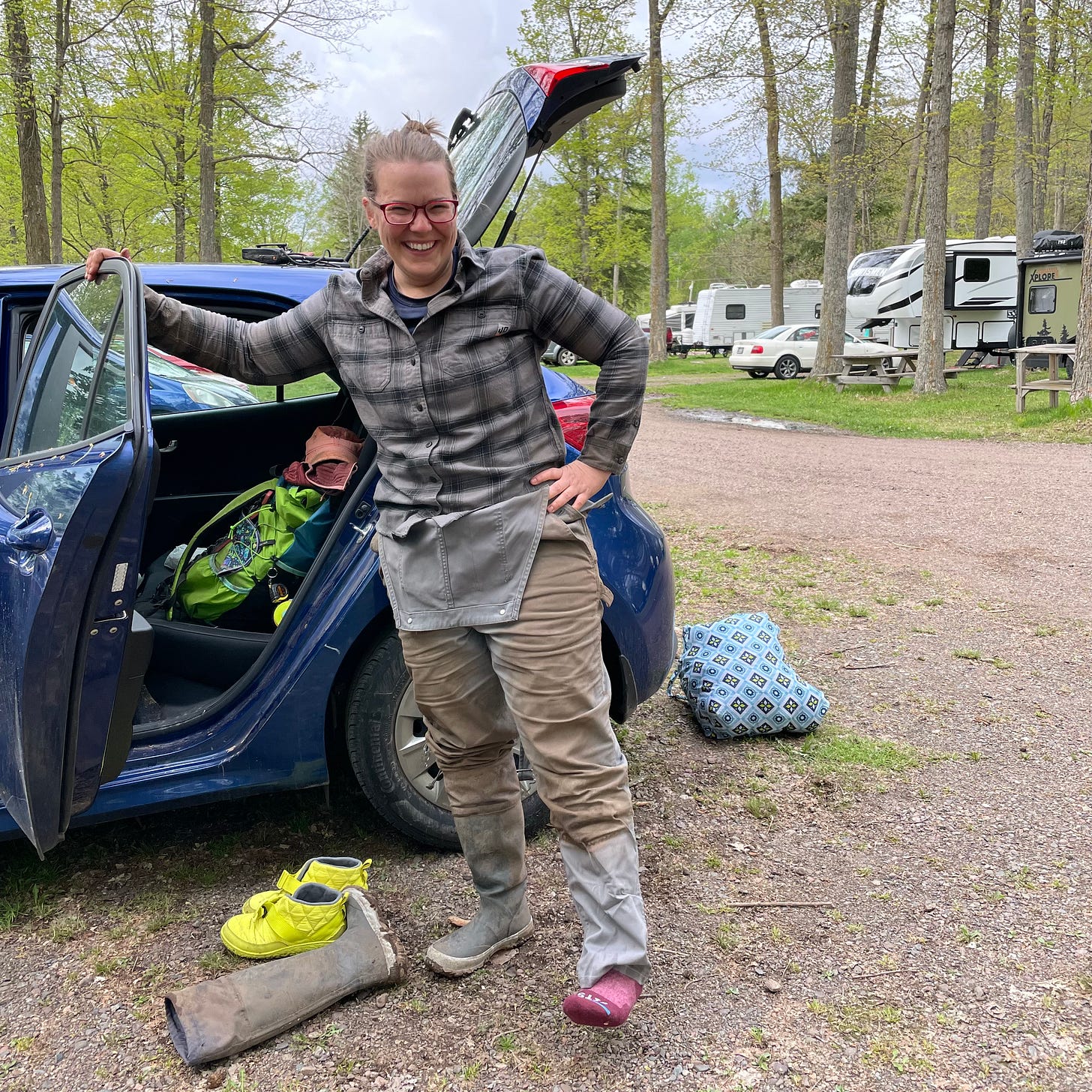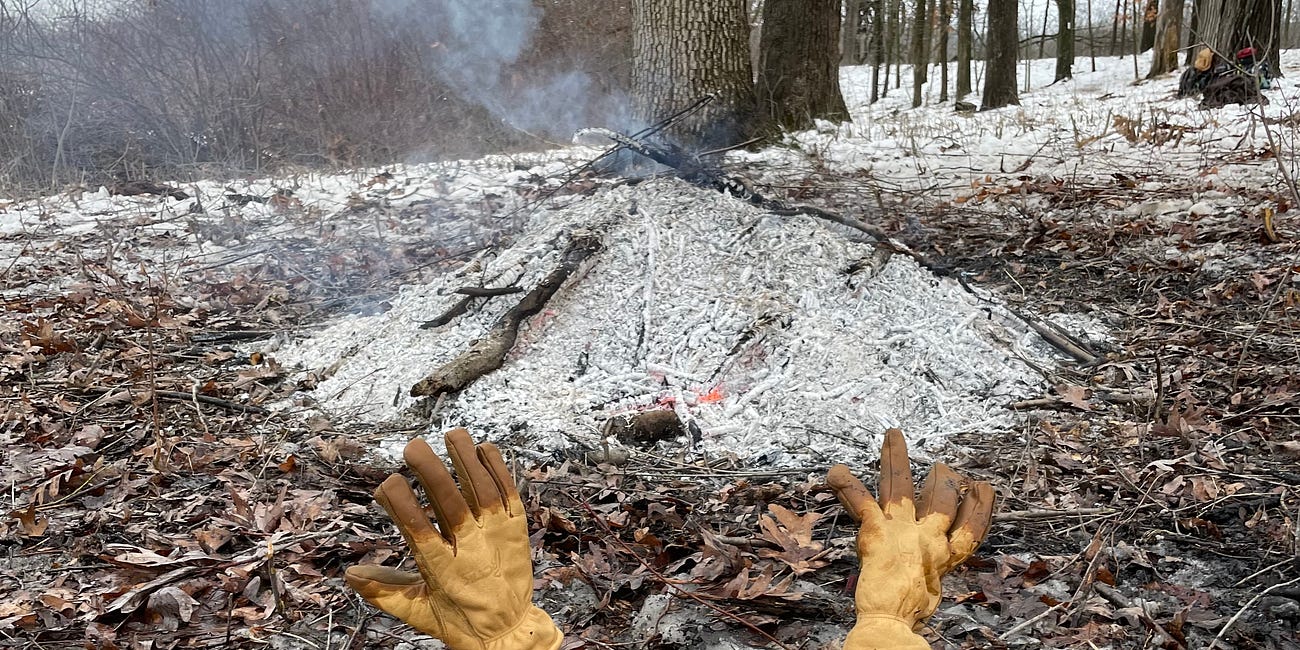Welcome back to Between A Mossy Rock And A Hard Place, the fortnightly advice column for all your outdoorsy conundrums! Regular essays about my outdoor (mis)adventures continue on Sunday.
This week’s question was submitted by Sick of ticks (and you can submit your own questions for a future column!):
What precautions do you take to reduce the likelihood of getting bitten by a tick? I’m terrified of getting Lyme or Alpha-gal and it feels like there are ticks on my local trails basically every month of the year.
Tick-borne diseases can be pretty nasty, so I put a fair bit of effort into preventing bites. With the amount of time I spend outdoors, it’s inevitable that ticks will crawl on me (though I wish they wouldn’t). Ticks are likely to be active anytime temperatures are above freezing, which coincidentally is also when I’m most likely to be active outdoors! Since I can’t keep them off of me entirely, my goal is to poison or remove the ticks before they can embed in my skin.
My first layer of defense is permethrin, an insecticide that I apply to my hiking clothes—pants, shirts, socks, hats, and boots. One treatment is supposed to last for six weeks (or six washes), so it doesn’t need to be sprayed on before every single hike. The idea is that as a tick crawls on you looking for a tasty spot to bite, it will come into contact with your permethrin-coated clothes. Though permethrin does not immediately kill the tick, it will quickly inhibit the tick’s ability to embed.
I’ve read many comments online about people successfully diluting farm-grade permethrin, however, I prefer to spend the extra money and buy the pre-diluted mix from Sawyer1. I did buy (and dilute) the farm-grade stuff once and the smell of it was incredibly off-putting and did not fade much over time.2 Yes, it was cheaper, but I didn’t end up using the whole bottle, so in the long run I didn’t save any money.
Be careful when treating your clothes because when permethrin is wet, it is toxic to cats. Since it is an insecticide, it’s also good to avoid spraying it in your garden, especially if you’re trying to attract pollinators to your yard! I typically hang my clothes in the back of the garage and spray them there. If you don’t have a good place to spray, you can also soak your clothes in permethrin. Read the instructions and warning labels before treatment!
Next, I use picaridin as my go-to bug spray. Unlike a standard bug spray you may pick up at a convenience store, picaridin is effective against both ticks and mosquitos. Though DEET is also effective against ticks, DEET can damage plastic. Since my glasses frames are plastic—not to mention various bits of my camping gear—I prefer to play it safe and use picaridin.
Since I strongly dislike the feel of fabric bunching around my ankles, I do not follow the standard advice of tucking my pant legs into my socks. What I do instead is treat my socks with permethrin and then roll up my pants to spray my bare legs from knee to ankle with picaridin, even though that skin wouldn’t be exposed while I’m hiking. For people who do tuck their pants into socks, pay attention to where on your body a tick would first be able to reach bare skin. A friend recently mentioned to me that she has been regularly finding ticks on her waistline and realized that it happened when she wore overalls and gaiters—the easiest access point for ticks just moved upwards from ankles to waist, but didn’t deter them!
At the end of the day or anytime I take an extended break, I will do a tick check. The midday ones are more cursory, but I try to be as thorough as possible before going to bed. This includes brushing my hair to make sure I’m not feeling any weird bumps on my scalp. My travel hairbrush has a mirror built into the handle, so that is a big help for trying to see my back when solo camping or backpacking. I also make sure to carry tweezers or a tick key in order to fully remove a tick that has already embedded itself in my skin.
If I’m camping near my car, I store my hiking or trailwork clothes in a laundry bag that has been treated with permethrin, rather than keeping them in my tent. This limits the number of ticks that might crawl on me while I’m asleep in my not-permethrin-treated pajamas. Since many trailbuilding projects3 are in heavy tick areas, I have also taken to spraying the trunk of my car (where my camping gear is) and the driver’s seat (where I am) with permethrin. There have been too many times where I spot a tick sprinting across my dashboard while I’m on the interstate, so I like the added security of knowing that the fabric in my car is an inhospitable environment to ticks.
If you’re concerned about bringing ticks into your house and want another layer of defense beyond the treated laundry bag, I’ve also seen recommendations online to put your hiking clothes in the dryer on high heat for about ten minutes before washing them to kill ticks.
Do you have more tick bite prevention tips? Please share them in the comments!
I want your questions!
Do you need a pep talk to go on your first solo camping trip?
Perhaps you’re unsure how to tell your longtime hiking partner that your ideas of what makes an ideal trip have diverged?
Sawyer products are available at REI and many other outdoor retailers.
I cannot overstate how strong the smell was—whatever you are imagining, double the stench. I diluted the farm-grade permethrin to spray the fabric in my car after finding ticks crawling all over the seats and it took weeks (yes, plural) before I could drive anywhere with the windows completely closed.
For previous thoughts about why I do volunteer trailwork:










This reminded me to reorder Sawyer's — and I'm totally spraying my trunk and driver's seat. It's a great idea I never thought of, and I've discovered ticks walking on me during my drive home, too!
Wow, I never thought of spraying my car seat. Great idea!